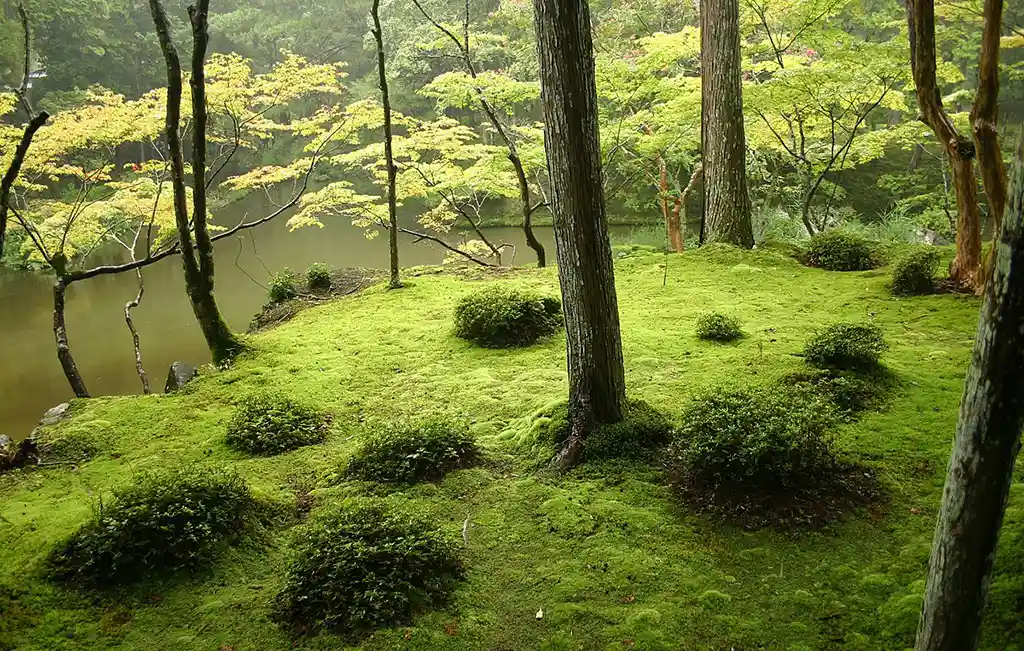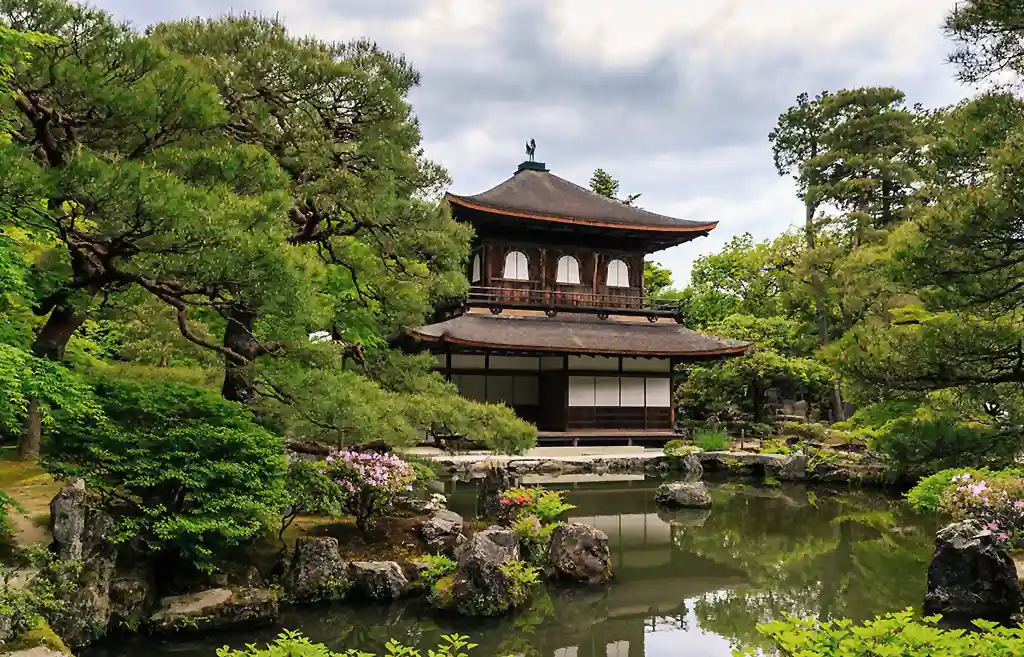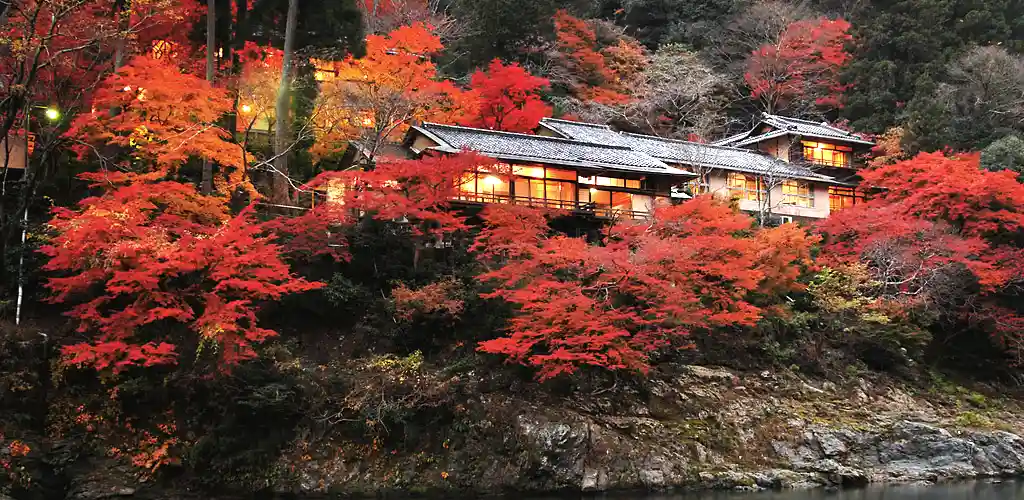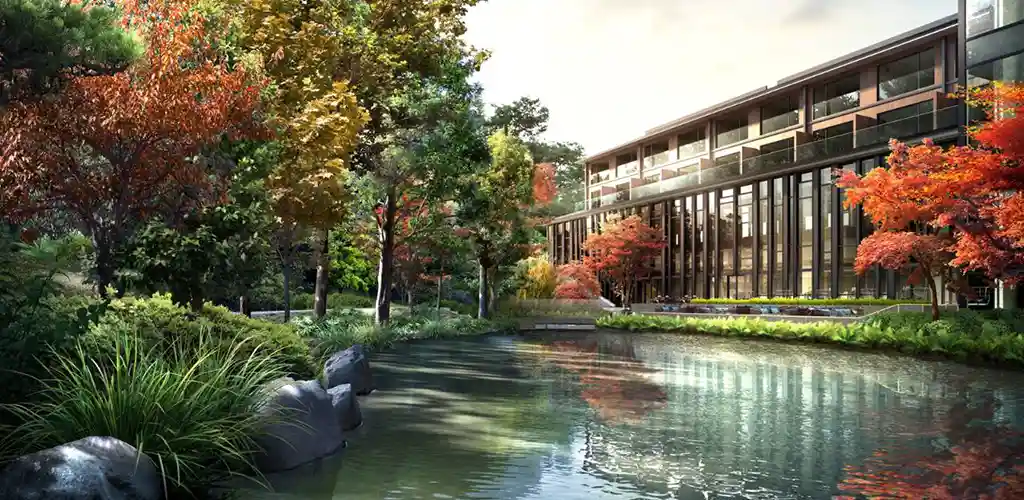Kyōto Imperial Palaces & Gardens
The four official Imperial Palace and Gardens are a highlight of a visit to Kyoto. Some places are open to the public, some closed, and other require advance permitting, which we can arrange for. The main Imperial Palace Park is accessible to all at anytime, though an application is required for visiting the palace and Sento Gosho garden within the park. The Katsura and Shugakuin Rikyu properties also require advance permit applications. Tours of the imperial properties are at set times, structured and formal. For those wishing to have more casual exploration, we can recommend alternative gardens and villas, some nearly as beautiful and interesting, such as the Okochi-Sanso Villa in Arashiyama, or secondary places not as well known, such as the sublime Saihō-ji (Koke-dera or “Moss”) Zen Buddhist Temple. Our half- or full-day stroll through Arashiyama also takes in beautiful gardens at the Nanzen-ji Temple, river area, famed bamboo forest, and villas (see below). Kyoto is surprisingly plain and urban for travelers expecting a lush setting of Zen temples. However, a few luxury properties do provide a bucolic escape within Kyoto (below).
Imperial Properties in Kyoto
1. Kyoto Gyoen (Kyoto Imperial Palace Park - central Kyoto)
2. Imperial Palace (within Kyoto Imperial Palace Park)
3. Sento Gosho Garden (within Kyoto Imperial Palace Park)*
4. Katsura Rikyu Imperial Villa (Arashiyama)*
5. Shugakuin Rikyu Imperial Villa Northern (Higashiyama)*
3. Sento Gosho Garden (within Kyoto Imperial Palace Park)*
4. Katsura Rikyu Imperial Villa (Arashiyama)*
5. Shugakuin Rikyu Imperial Villa Northern (Higashiyama)*
5. Shugakuin Rikyu Imperial Villa Northern (Higashiyama)*
*Visitor application & permit required

1/ Kyoto Gyoen (Imperial Palace Park) – 2/ Imperial Palace – 3/ Sento Gosho Garden

A lush haven on the urban plain of Kyoto, the Kyoto Gyoen (Kyoto Imperial Palace Park). Described as Kyoto's equivalent of Central Park, this park envelops the Imperial Palace complex and encompasses the Sento Gosho, an expansive walled garden adorned with serene ponds, winding pathways, and an array of vibrant flora. For those inclined towards gardens rather than historical architecture, the Sento Gosho is the most attractive of properties. Essentially, the Sento Gosho functions as a secluded park within the broader Kyoto Imperial Palace Park. Visitors are required to join a guided tour by application (we will assist).
Unlike the imperial properties it surrounds, the Imperial Palace Park (Gyoen National Garden) can be entered free of charge and without any application procedure (see map below). Situated within the expansive Kyoto Imperial Palace Park, the Kyoto Imperial Palace comprises a walled compound adorned with multiple buildings constructed in the traditional Japanese architectural style. A guided tour of the compound alongside a large group can evoke a sense of a school outing, yet the Imperial Palace may pique the interest of ardent enthusiasts of Japanese history. Among the four imperial properties in Kyoto, namely the Kyoto Imperial Palace, Katsura Rikyu, Sento Gosho, and Shugaku-in Rikyu, the Imperial Palace is generally regarded as the least captivating being newer, with low-profile buildings and gardens that fail to match the splendor of others in Kyoto, while the tour itself tends to be overly structured. Two periods a year the palace can be visited without special permission (around the last week of April and the middle of November), otherwise in order to visit the Kyoto Imperial Palace (and the Gosho), you must apply to the Kunaicho (Imperial Household Office). We will assist with this process.
Kyoto Imperial Palace Official Visitor Notes
- Visiting the Imperial National Park only: Enter Seishomon Gate of the Kyoto Imperial Palace (Gyoen National Garden)
- No application (no prior arrangement) required.
- You and your belongings will be subject to security checks at the entry gate.
- In addition to self-guided visit, free guided tours are available in English at 10:00A & 2:00P for free and no registration is required.
- The tour will not take you into the Kyoto Palace or Sento Gosho. If you wish to participate in the tour, please come to the Visitors Room on the right of the entrance before the tour starts. The duration of the tour is approximately 50 minutes. Please note that the tours may be subject to change or last-minute cancellation.
- For self-guided visitors, a free multi-language (with English, French, Spanish) audio guide app. is available for download: https://www.kunaicho.go.jp/e-event/app.html
- The Palace may be closed without notice due to sudden scheduling of visit of dignitaries or some other reasons.
- Pets and large baggage cannot be taken into the Palace.
- For safety and security reasons, a one-way system operates along the visitor route.
- Please obey the instructions of staff members.
- You can take photographs. However, using drones, camera stands or other related equipment for commercial filming are not permitted.
- Using public transport is recommended because parking facilities for cars and bicycles are not available.
- Wheelchairs are available. Please ask our staff for assistance at the entrance


4/ Katsura Rikyu Imperial Villa (“Katsura Detached Palace”) - Arashiyama

The epitome of Japanese architectural and garden style, the Katsura Rikyu Imperial Villa near Arashiyama seamlessly combines the most exquisite techniques of Japanese design. A must-visit for those with interest in Japanese architecture and gardens. Nonetheless, there are a few aspects that may diminish the experience to consider (shared in all imperial properties) including the requirement to obtain permission by application, obligatory group tour which restricts the opportunity to leisurely enjoy the garden's ambiance, and its location in Kyoto, surrounded by mundane suburbs. For those seeking an equally remarkable Japanese garden and traditional architecture, we recommend instead visiting the nearby Okochi-Sanso Villa. Unlike Katsura Rikyu, which can be visited without permission at any time and is nearly as beautiful as Katsura Rikyu.
Katsura Rikyu Imperial Villa Official Visitor Notes
- Children below 12 years of age are not permitted to enter Katsura Rikyu Imperial Villa.
- The villa is often closed on Saturday, Sunday and national holidays.
- Tours in English start at 10am, 11am, 2pm and 3pm. Arrive about 20 minutes before the start of the tour. Tours last 40 minutes.

5/ Shugakuin Rikyu Imperial Villa (“Shugaku-in Detached Palace”) – Higashiyama
Situated in the northeastern part of Kyoto, on the slopes of Mt. Hiei, the Shugakuin Rikyu Imperial Villa stands as the most expansive and, in many respects, the most delightful among Kyoto's four imperial properties. The villa comprises a pleasant collection of gardens and structures spread over a vast expanse of hillside, offering breathtaking views of Kyoto. Similar to the other three imperial properties in the city, obtaining permission from the Imperial Household Agency is necessary to visit (which we will assist with), and participation in a guided tour is mandatory. Unfortunately, this means that exploring freely and at your own leisure is not permitted, somewhat diminishing the overall experience. Nevertheless, the villa's lush pathways, captivating pond, and panoramic vistas of the city make a visit worthwhile, particularly for those fortunate enough to have several days to spend in Kyoto.

Shugakuin Rikyu Imperial Villa Official Visitor Notes:
- Prior registration required
- Closed Mondays and New Year holidays (December 28 - January 4).
- Tour times (free): 9am, 10am, 11am, 1:30pm, and 3pm (80min).
- Maximum number of visitors; 50 persons per time slot.
- An audio guide is available for non-Japanese speakers.
![]() Official Imperial Properties Full Visitor Guidelines
Official Imperial Properties Full Visitor Guidelines

Other Notable Kyoto Temples & Gardens
Saihō-ji (Koke-dera) “Moss” Temple - Nishikyō Ward

A lush green Zen Buddhist temple with sprawling moss garden. A visit also requires an advance permit (we will assist in applying). Located in the Nishikyō Ward, not far from Arashayama. A UNESCO World Heritage site, the garden of Saihō-ji is acclaimed by many as Kyoto’s most beautiful garden. Three teahouses to relax and contemplate the surroundings. Opens at 10AM with sporadic closing dates. A peaceful alternative to Kyoto's more crowded sites.
Ginkaku-ji Temple (Silver Pavilion) Garden

The Shogun stroll garden at Ginkaku-ji Temple is one of the finest traditional gardens in all of Japan. Designed by the renowned landscape artist Sōami in the 1400s, it features various styles including a dry sand garden (Sea of Silver Sand), marked by a massive cone of sand symbolizing Mount Fuji. There are also sublime moss gardens around the ponds, streams and variety of flora. Open daily 8:30A to 5:00P.
Tenryu-ji Temple Garden

In the lush Arashiyama district, a highlight of our walking tour, below, is one of Kyoto's finest Zen temples and one which we recommend to avoid the crowds at the more popular sites such as the Golden Pavilion. The magnificent stroll garden is towered over by scenic mountains creating a stunning backdrop. In the spring the cherry blossoms are abundant and in the autumn the trees are awash in a tableau of fiery color.
Arashiyama
Our pleasant half- or full-day stroll through Eastern highlights of Kyoto features the exceptional temples, villas, and gardens of the scenic Arashiyama district.

Emperor Kameyama named the Togetsukyo bridge, or "Crossing Moon Bridge,” when he commented one cloudless night that the moon appeared to be traveling across the bridge. Also nearby is one of Kyoto's most beloved gardens at the Tenryuji temple, on the way to the iconic bamboo forest (below) and sublime Okochi Villa. There is a short hike up Mount Arashiyama (30 minutes) offering expansive views of Kyoto along with visiting the semi-wild monkeys in the forest (a must-see for children). If you are staying at Hoshinoya, this walk takes place from the ryokan.

Nanzen-ji
A towering Buddhist temple up the hill from Gion and Maruyama Park. Featuring multi-storied wooden structures, magnificent gates and a sublime rock garden. Adjacent a former head priest’s residence, Hojo, is a tranquil Zen garden, fringed by picturesque trees and perfectly raked rock garden. In the Autumn all around the temple is spectacular fall foliage. The temple lane is lined with vegetarian restaurants with the tofu restaurant, Junsei, a standout for its serene garden. Note: We typically recommend UNESCO-designated Kiyomizu-dera located close by over Nanzen-ji but can substitute for those with interest in traditional gardens.
Nijo Castle

The vast grounds of Nijo are picturesque and actually the real highlight a visit, replete with tranquil ponds, countless large stones and cherry and plum trees making it a pleasant visit during sakura. However, unless you have extended time in Kyoto, forego what is really a plainer castle, and often crowded, for other more interesting sites in Kyoto.

Tranquil Hotel Sanctuaries in Kyoto
Older luxury hotels in Kyoto do not reflect the bucolic and sublime settings of many of the famed temples and gardens the city is renowned for. However, a few luxury properties have opened in recent years that are exceptional sublime escapes.
Aman Kyoto

Kyoto's newest, and apart from the Hoshinya, is the town's most secluded. Nature dominates at the newest Aman Kyoto – Aman’s third property in Japan after Tokyo and the hot spring retreat Amanemu. Aman Kyoto is situated in an lush remote garden, surrounded by acres of dense forest, featuring scattered austere pavilions amongst the trees. Large open spaces are spread within and outside, and there is a tranquil spa with hot spring onsen and a pair of high-quality restaurants serve up home-cooked Kyoto-style cuisine and Western dishes, as well as afternoon tea with sweet wagashi (confections).
Sublime Zen rock gardens, fountains, and a four-story waterfall create peaceful settings in the resort's center. The interiors were created by Peter Remedios, who also worked on the Kyoto Ritz, and Spin Studios drawing from the traditions of Japan, featuring elements by local artisans.
Hoshinoya

In the style of traditional Japanese homes with 21st-century architecture, this sublime 25-room ryokan sits high on the banks above the dreamy Hozugawa River, transporting one back in time. Located in the Arashiyama district, an area abundant with temples, the hotel is reached only by a slow cruise in a hinoki, a traditional cedar boat. The rooms are richly finished in cedar, hand-blocked wallpaper, modern floor-to-ceiling glass shoji screens and chic dark slate bathrooms, with wide picture windows, and lofty duvets, not tatami mats, to relax on. All guest rooms feature views of the tranquil river surrounded by a tree-covered landscape that changes with the seasons.
Four Seasons Kyoto

The Four Seasons Kyoto features a standout location in Kyoto, situated right within the historic Higashiyama district, but with a tranquil and sublime setting upon a centuries-old garden and pond. Modern rooms with traditional styles are crafted with dark hardwood floors and hand-painted wooden panels with fusama screens of bright shades of pale blue and imperial purple. Spacious bathrooms are dominated by inviting large soaking tubs. A number of signature suite rooms also have balconies and beautiful views of the gardens. It's also the location that's key here, with the Kamo River only a couple of blocks away, the Kyoto National Museum, a short stroll, and a pair of less popular temples nearby and other highlights of the area, including Gion, are also not far.

